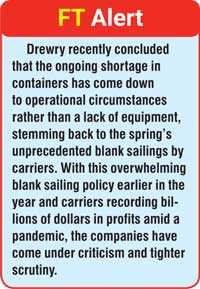Thursday Mar 06, 2025
Thursday Mar 06, 2025
Monday, 28 December 2020 00:00 - - {{hitsCtrl.values.hits}}

Hapag-Lloyd Chief Executive Rolf Habben
Supply chains could benefit from higher levels of inventory to protect them against future shocks, according to Hapag-Lloyd Chief Executive Rolf Habben Jansen.
The head of the world’s fifth-largest carrier told a webinar that the coronavirus pandemic has shown that longer time horizons than just a few weeks in decision-making would benefit supply chains stakeholders.
The containership market today is under very strong demand pressures and the very high spot rates have been compounded by port congestion and box shortages.
Habben Jansen said the push by customers to slash inventories at the start of the pandemic in March made sense as a cost cutting exercise when demand was falling. But it has also proven to be one of the root causes of why there is so much supply pressure today with the demand resurgence.
After the steep decline in the first months of the pandemic, global demand bounced back over the  summer and especially over the past three to four months has shown “unprecedented and enormously quick and strong rebound” that caught people by surprise and caused difficulties in the supply chains, said Habben Jansen.
summer and especially over the past three to four months has shown “unprecedented and enormously quick and strong rebound” that caught people by surprise and caused difficulties in the supply chains, said Habben Jansen.
That abrupt change has shown that having a little bit of inventory in the supply chain is not such a bad idea, he said, as it could smooth the landing. “Because it just gives you a lot more time and room to react rather than being in a situation where everything is very tight,” he said.
Habben Jansen said that despite efforts to add boxes and there being more ships sailed in the market, it had been difficult to satisfy demand.
Drewry recently concluded that the ongoing shortage in containers has come down to operational circumstances rather than a lack of equipment, stemming back to the spring’s unprecedented blank sailings by carriers.
With this overwhelming blank sailing policy earlier in the year and carriers recording billions of dollars in profits amid a pandemic, the companies have come under criticism and tighter scrutiny.
Habben Jansen rejected the notion that companies are being greedy, but he did acknowledge that this will be the first year in a decade that Hapag-Lloyd will earn back its cost of capital.
“It is also true that the spot rates we see are very, very high on many trades,” he said.
That is why Hapag-Lloyd is exploring longer-term agreements with some of its customers.
The massive blank sailings undertaken at the start of the pandemic were about cost management, he said. Within 10 days between March and April, Hapag-Lloyd’s volumes were dropping by 20%, which meant a decline of $6m-$7m in revenues per day, forcing the company to take ships out of the market.
“I think it was a matter of survival more than anything else,” Habben Jansen said.
Looking ahead, the Hapag-Lloyd chief executive said that high rates could last until sometime into the second quarter because of continual port congestion and because of efforts in Asia to continue production throughout the Chinese New Year.
“But to be honest, I also don’t know. We’ve all been proven wrong many times in the last months,” he said.
Discover Kapruka, the leading online shopping platform in Sri Lanka, where you can conveniently send Gifts and Flowers to your loved ones for any event including Valentine ’s Day. Explore a wide range of popular Shopping Categories on Kapruka, including Toys, Groceries, Electronics, Birthday Cakes, Fruits, Chocolates, Flower Bouquets, Clothing, Watches, Lingerie, Gift Sets and Jewellery. Also if you’re interested in selling with Kapruka, Partner Central by Kapruka is the best solution to start with. Moreover, through Kapruka Global Shop, you can also enjoy the convenience of purchasing products from renowned platforms like Amazon and eBay and have them delivered to Sri Lanka.
Discover Kapruka, the leading online shopping platform in Sri Lanka, where you can conveniently send Gifts and Flowers to your loved ones for any event including Valentine ’s Day. Explore a wide range of popular Shopping Categories on Kapruka, including Toys, Groceries, Electronics, Birthday Cakes, Fruits, Chocolates, Flower Bouquets, Clothing, Watches, Lingerie, Gift Sets and Jewellery. Also if you’re interested in selling with Kapruka, Partner Central by Kapruka is the best solution to start with. Moreover, through Kapruka Global Shop, you can also enjoy the convenience of purchasing products from renowned platforms like Amazon and eBay and have them delivered to Sri Lanka.